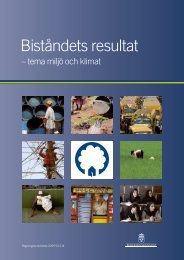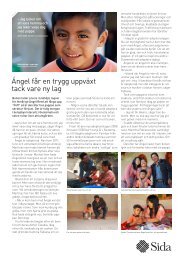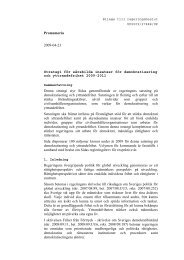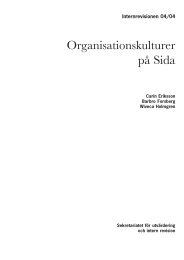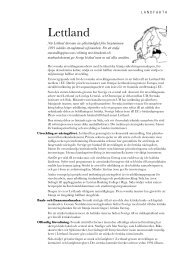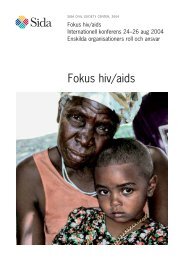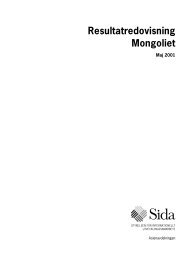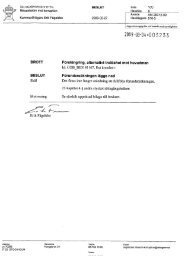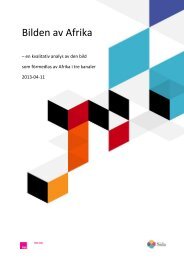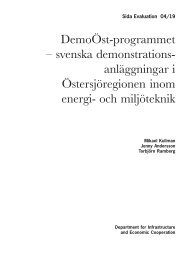Mid-Term Review of the AGIR Programme - Sida
Mid-Term Review of the AGIR Programme - Sida
Mid-Term Review of the AGIR Programme - Sida
You also want an ePaper? Increase the reach of your titles
YUMPU automatically turns print PDFs into web optimized ePapers that Google loves.
A N N E X 3 – I N C E P T I O N R E P O R T<br />
Additional questions to be considered are:<br />
i) What is <strong>the</strong> relationship between sub-programme content and <strong>the</strong> achievement<br />
<strong>of</strong> intended outcomes? Are <strong>the</strong>re content areas that are more difficult to work<br />
in and <strong>the</strong>refore prove to be more difficult to achieve results?<br />
ii) Can territorial linkages (national, regional, provincial, local) contribute to sustainability?<br />
How? What kinds <strong>of</strong> mechanisms are involved to make this<br />
happen?<br />
iii) What outcomes have resulted within <strong>the</strong> programme that can be specifically<br />
linked to its work in gender and human rights-based approaches? Are <strong>the</strong>se<br />
outcomes unique?<br />
Proposed approach and methodlogy<br />
Evaluation approach<br />
A central perspective taken by this evaluation is that <strong>the</strong>re are multiple ‘spheres <strong>of</strong><br />
influence’ in <strong>the</strong> <strong>AGIR</strong> programme linked toge<strong>the</strong>r through relationships between<br />
donors and intermediaries, intermediaries and partner CSOs, and CSOs and <strong>the</strong>ir own<br />
partners in <strong>the</strong> communities in which <strong>the</strong>y work. Given <strong>the</strong> structure <strong>of</strong> <strong>the</strong> <strong>AGIR</strong><br />
programme (one programme with sub-programme intermediaries partnering with<br />
local CSOs) and its focus on capacity streng<strong>the</strong>ning processes, a clear understanding<br />
<strong>of</strong> <strong>the</strong> different ‘spheres <strong>of</strong> influence’ within <strong>the</strong> <strong>AGIR</strong> programme is necessary to<br />
identify and assess outcomes related to <strong>the</strong> programme approach.<br />
While <strong>the</strong> assessment <strong>of</strong> each intermediary’s ‘internal’ organisational capacity 53 to<br />
undertake its work with its CSO partners can be more directly linked to <strong>the</strong> support<br />
provided by <strong>the</strong> Swedish Embassy through <strong>the</strong> <strong>AGIR</strong> programme, outcomes related<br />
to <strong>the</strong> work <strong>of</strong> <strong>the</strong> intermediaries with <strong>the</strong>ir CSO partners are more downstream. Identifying<br />
and understanding <strong>the</strong>se different ‘spheres <strong>of</strong> influence’ through a relevant<br />
‘<strong>the</strong>ory <strong>of</strong> change’ will be necessary to produce a strong evidence-based narrative that<br />
plausibly links <strong>the</strong> contribution <strong>of</strong> <strong>the</strong> programme and <strong>the</strong> work <strong>of</strong> <strong>the</strong> intermediary<br />
organisations to downstream outcomes at <strong>the</strong> CSO partner level. As mentioned earlier,<br />
documenting <strong>the</strong>se ‘change pathways’ and <strong>the</strong> linkages <strong>the</strong>y represent between<br />
outputs, outcomes and impact will be central to understanding <strong>the</strong> progress to date <strong>of</strong><br />
<strong>the</strong> <strong>AGIR</strong> programme. These ‘pathways’ exist as a result <strong>of</strong> <strong>the</strong> <strong>AGIR</strong> programme<br />
focus on <strong>the</strong> relationships between <strong>the</strong> various actors involved in <strong>the</strong> programme and<br />
are critical to its ability to sustain this progress in <strong>the</strong> near and long-term future. This<br />
‘<strong>the</strong>ory <strong>of</strong> change’ will be used to stimulate and structure critical reflection about<br />
53 Internal Organisational capacity can consist <strong>of</strong> many elements from training, to financial management<br />
and human resource capacities. In each case, it is <strong>the</strong> development <strong>of</strong> <strong>the</strong> ‘capacity’ <strong>the</strong> organisation<br />
has to support o<strong>the</strong>rs in a more effective way.<br />
100




